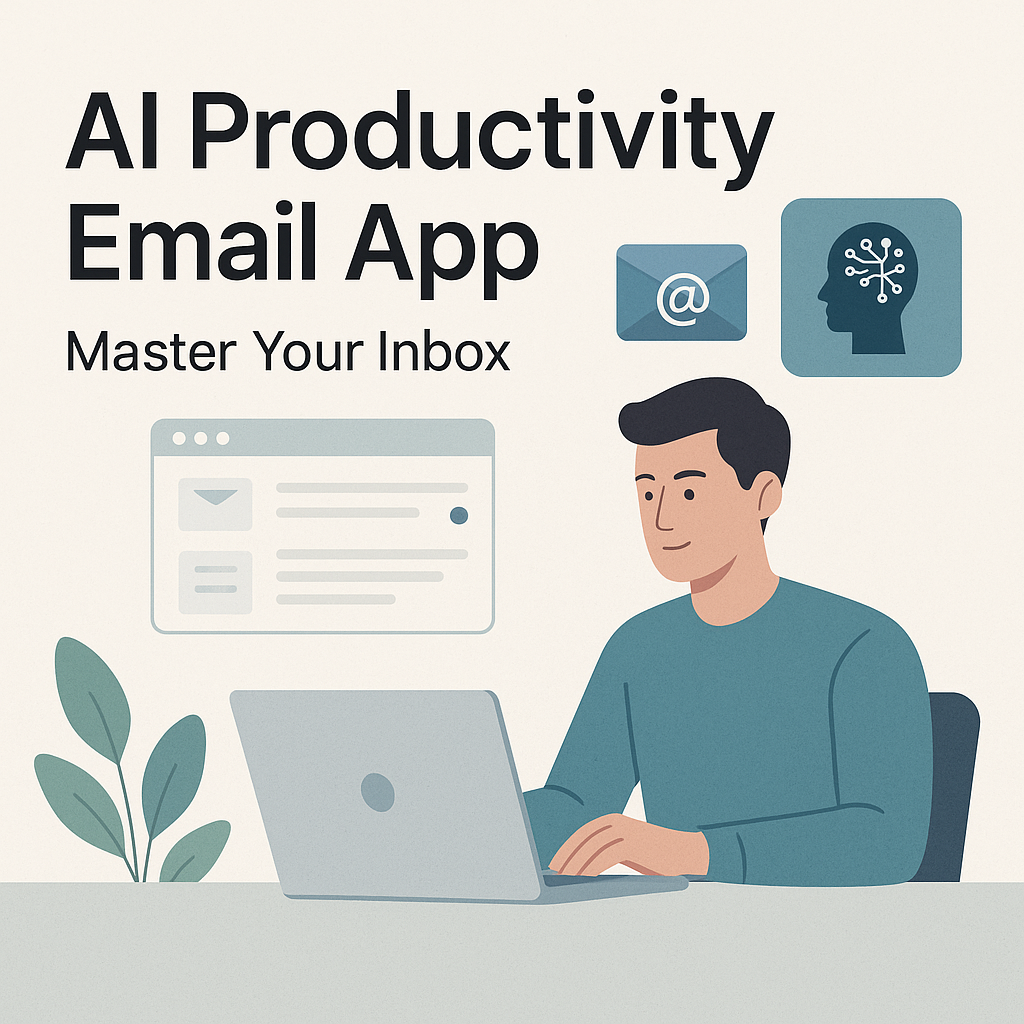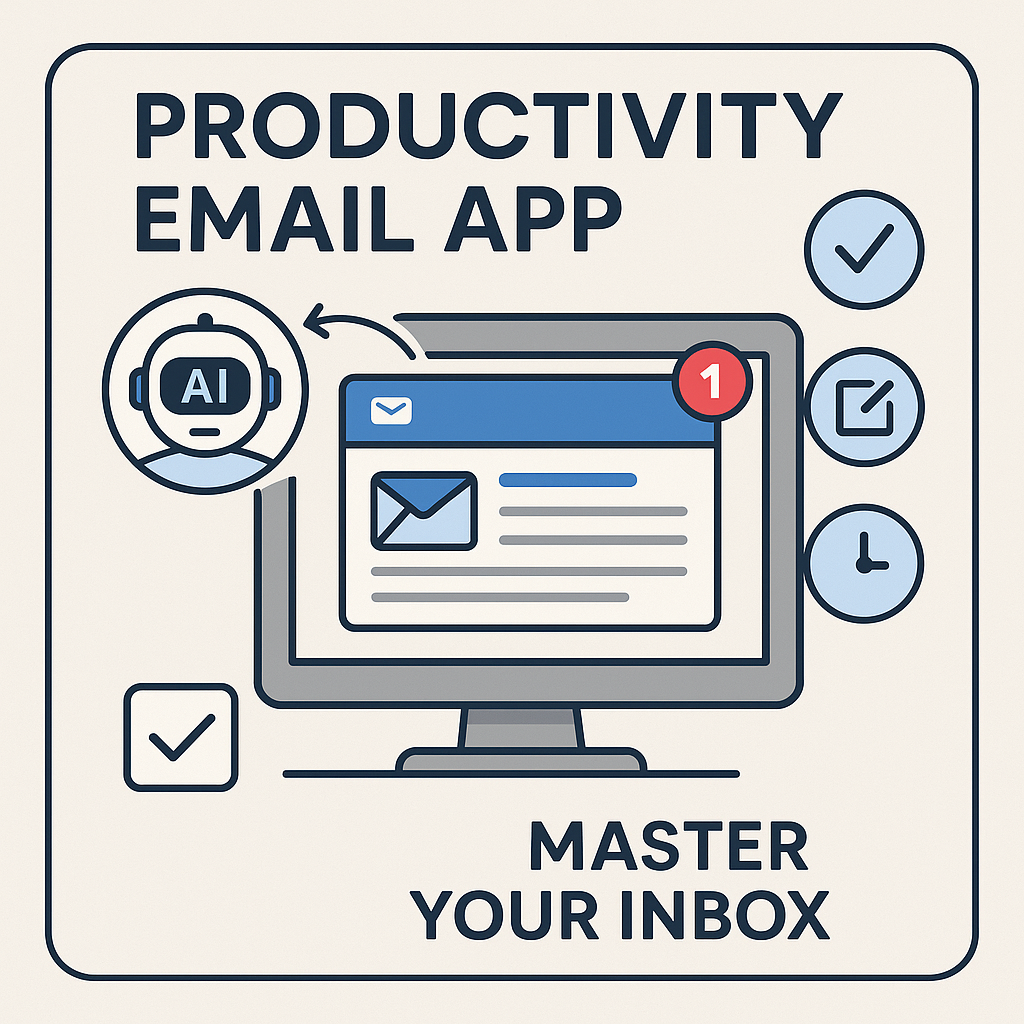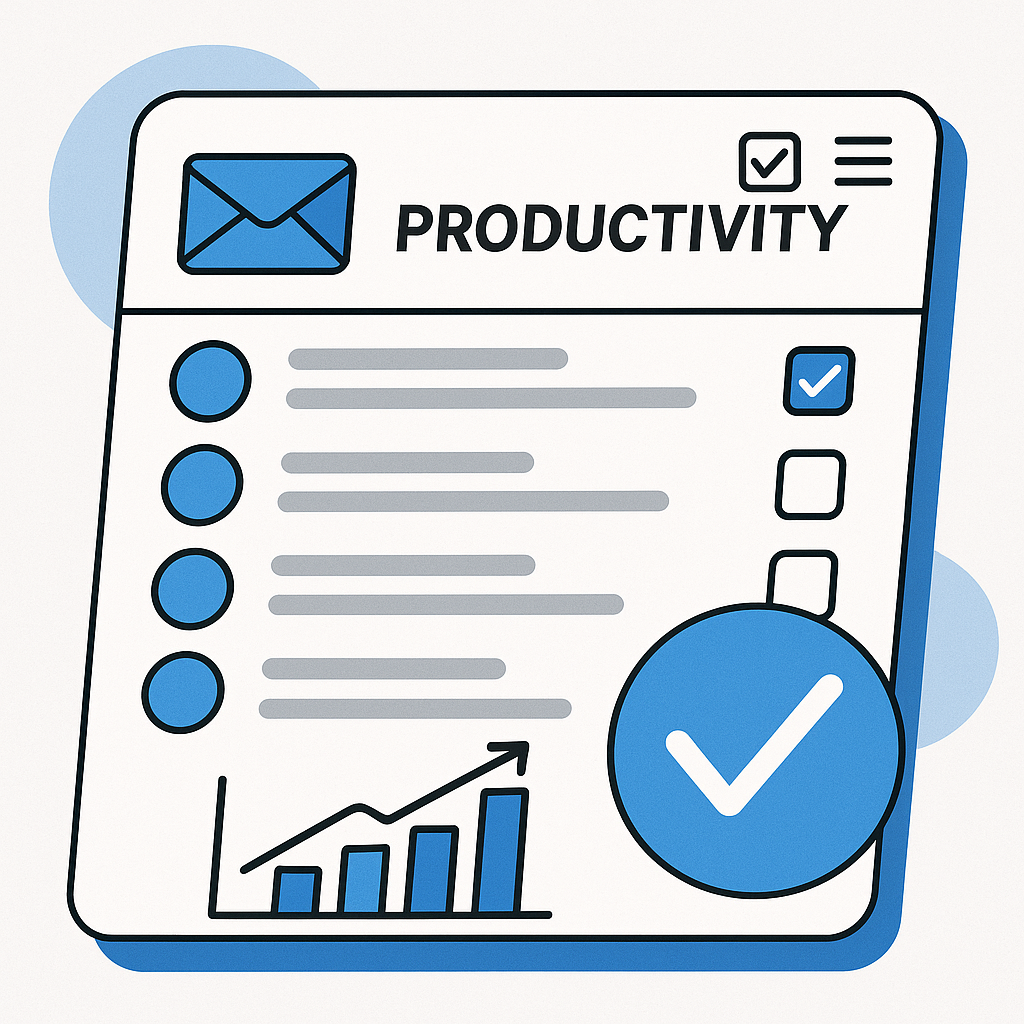AI Productivity Email App: Master Your Inbox

In today's fast-paced professional world, the humble email inbox has become a double-edged sword. It's an indispensable tool for communication, collaboration, and commerce, yet for many, it's also a relentless source of overwhelm. We spend countless hours sifting, sorting, responding, and organizing, often feeling like we're drowning in a digital sea of messages. Statistics consistently show that professionals can spend upwards of 20-30% of their workday managing email. This drain on time and mental energy directly impacts our ability to focus on strategic tasks, innovate, and drive growth. But what if there was a way to not just manage your inbox, but to truly master it? Enter the era of the AI productivity email app.
Understanding AI-Augmented Productivity Frameworks for Email
The concept of "AI-augmented productivity frameworks" for email might sound complex, but at its core, it's about leveraging artificial intelligence to enhance and streamline your existing email workflows. It's not about replacing human interaction but about empowering individuals with intelligent tools that handle the repetitive, time-consuming aspects of email management. These frameworks are designed to work alongside you, making your communication more efficient and your inbox more manageable.
What are AI-Augmented Productivity Frameworks?
Think of these frameworks as an intelligent layer built upon your current email system. They utilize machine learning algorithms and natural language processing (NLP) to understand the content, context, and urgency of your emails. Instead of manually sorting through hundreds of messages, AI can automatically categorize them, identify priorities, suggest responses, and even automate certain actions. This intelligent augmentation transforms email from a chore into a strategic asset, allowing professionals to reclaim valuable time and cognitive load.
The AI Advantage in Email Management
The primary advantage AI brings to email management is its ability to process vast amounts of data quickly and learn from user behavior. This allows for:
- Efficiency Boost: Automating repetitive tasks frees up significant time.
- Improved Focus: By filtering out noise and highlighting critical messages, AI helps professionals concentrate on what truly matters.
- Enhanced Communication: AI can help refine messages, suggest optimal send times, and even analyze sentiment to improve interactions.
- Reduced Stress: A cluttered and overwhelming inbox is a major source of professional stress. AI-driven solutions aim to alleviate this.
As we explore various AI productivity tools, it becomes clear that AI isn't just a futuristic concept; it's a present-day solution for tackling one of the most persistent productivity challenges.
Key AI Features for Enhancing Email Management
Modern AI-powered email solutions offer a suite of sophisticated features designed to tackle inbox overload head-on. These capabilities go far beyond simple filtering, offering intelligent insights and automation.
Smart Sorting and Categorization
One of the most immediate benefits of an AI-driven inbox is its ability to intelligently sort and categorize your emails. Instead of a single, overwhelming stream, AI can automatically segment your messages into relevant categories like 'Important,' 'Promotions,' 'Notifications,' 'Team Updates,' or even custom project-based folders. This smart inbox management ensures that critical communications are easily discoverable, while less urgent items are neatly organized, reducing visual clutter and the cognitive effort required to find what you need.
Intelligent Prioritization
Not all emails are created equal. AI can analyze various factors – sender reputation, keywords, previous interactions, and even the sentiment expressed in the message – to determine urgency. It can flag emails that require immediate attention, helping professionals prioritize their responses and avoid missing critical deadlines or opportunities. This feature is invaluable for anyone juggling multiple projects or dealing with high-volume client communication.
Automated Email Tasks
Repetitive tasks are prime candidates for AI automation. This includes:
- Auto-Responses: AI can draft standard replies for common queries or acknowledge receipt of messages, setting expectations for when a full response will be provided.
- Meeting Scheduling: AI can parse email requests for meetings, find available slots in your calendar, and send out invitations, drastically simplifying the coordination process.
- Task Creation: If an email contains a clear action item, AI can suggest creating a task in your to-do list or project management tool, ensuring nothing falls through the cracks.
- Follow-up Reminders: AI can monitor emails that require a follow-up and prompt you or even send automated follow-up messages if no response is received.
These capabilities help to automate email tasks that would otherwise consume significant manual effort.
Sentiment Analysis for Communication
Understanding the tone of an email is crucial for effective communication. AI-powered sentiment analysis can gauge the emotional tone of incoming messages, helping you gauge customer satisfaction, identify potentially irate clients, or understand the urgency of a request based on the sender's expressed emotion. This insight allows for more empathetic and appropriate responses, improving professional relationships and customer service. This is a key aspect of how email artificial intelligence is transforming business communication.
Leveraging AI for Efficient Communication and Response Strategies
Beyond managing the inbox itself, AI can significantly enhance the quality and efficiency of the communication you send and receive. It acts as a co-pilot, refining your messages and optimizing your outreach.
Drafting and Responding Smarter
AI tools are becoming increasingly adept at assisting with email composition. They can help you:
- Draft Emails: Based on a few key points or a prompt, AI can generate complete email drafts, saving you the time and mental effort of starting from scratch.
- Suggest Replies: For common questions or standard acknowledgments, AI can offer pre-written responses that you can quickly select or adapt.
- Improve Tone and Clarity: AI can analyze your writing for tone, grammar, and clarity, suggesting improvements to ensure your message is professional and effective. Tools like ChatGPT for Gmail are examples of this emerging capability.
Optimizing Send Times and Follow-ups
Sending an email at the right time can dramatically increase its chances of being read and acted upon. AI can analyze patterns in your recipients' behavior or general engagement data to predict optimal send times. Furthermore, AI can manage follow-up sequences, ensuring that important messages don't get lost in the shuffle and that your outreach efforts are consistent. Tools often predict optimal send times to increase engagement, a feature highlighted by various AI email inbox management tools.
Personalization at Scale
In sales and marketing, personalization is key to effective engagement. AI can help analyze prospect data and past interactions to tailor email content, making each message feel more individual and relevant. This is crucial for effective lead generation email campaigns and building stronger customer relationships. By automating personalized touches, AI allows professionals to scale their outreach without sacrificing quality.
Case Studies: How AI Transforms Email Productivity for Different Roles
The impact of AI in email management is not uniform; it provides tailored benefits across various professional roles, addressing their unique challenges.
For Executives and Leaders
Executives are often swamped with high-level communications, strategic proposals, and internal reports. AI can act as a powerful gatekeeper and summarizer. It can filter out non-essential messages, provide concise summaries of long email threads, and flag critical items requiring their direct attention. This allows leaders to stay informed without getting bogged down, dedicating more time to strategic decision-making and leadership.
For Entrepreneurs and Small Business Owners
Entrepreneurs wear many hats, and email management is often one of the most time-consuming. AI can automate customer service inquiries, manage appointment scheduling, and help prioritize leads, freeing up entrepreneurs to focus on business growth, product development, and client acquisition. This is akin to having a virtual assistant that never sleeps.
For Sales Professionals
Sales teams rely heavily on email for prospecting, nurturing leads, and closing deals. AI can automate follow-up emails, personalize outreach based on prospect behavior, identify hot leads, and even help draft compelling sales messages. By automating these tasks, sales professionals can spend more time engaging with prospects and less time on administrative work. Mastering cold email outreach becomes far more efficient with AI assistance.
For Marketing Teams
Marketing departments use email for customer engagement, campaign management, and support. AI can help segment audiences, personalize campaign messages, automate responses to common customer inquiries, and analyze campaign performance data. This leads to more effective marketing strategies and improved customer satisfaction.
For Remote Workers
With dispersed teams, clear and efficient communication is paramount. AI can help remote workers stay on top of team updates, project communications, and client interactions. It can facilitate smoother collaboration by ensuring messages are routed correctly, providing summaries of lengthy discussions, and helping manage communication across different time zones. For those looking for alternatives to existing solutions, exploring options like SaneBox alternatives that leverage AI can be beneficial.
Implementing AI Tools: Practical Steps for Adoption and Best Practices
Integrating AI into your email workflow requires a thoughtful approach to maximize benefits and ensure a smooth transition.
Choosing the Right AI Productivity Email App
The market offers a variety of AI-powered email solutions. When selecting a tool, consider your specific needs:
- Features: Does it offer smart sorting, prioritization, automated responses, and drafting assistance?
- Integration: Does it integrate seamlessly with your existing email client (e.g., Gmail, Outlook) and other productivity tools?
- Ease of Use: Is the interface intuitive? Is there a learning curve?
- Security and Privacy: Ensure the tool adheres to strict data protection standards, especially when dealing with sensitive business information.
When selecting the right AI tools, consider solutions that offer robust features. For instance, integrating an ai executive assistant can significantly streamline your workflow, acting as a digital aide to manage complex communication.
Gradual Integration and Training
Don't try to implement every AI feature at once. Start with one or two key functions, such as smart sorting or automated acknowledgments. Allow yourself time to get accustomed to how the AI works and how it impacts your daily routine. Many AI tools also offer training resources or tutorials to help users get the most out of their capabilities.
Maintaining Human Oversight
While AI is powerful, it's essential to maintain human oversight. AI can make mistakes, and nuanced communication often requires human judgment. Always review AI-generated drafts or automated responses before sending them, especially for critical communications. AI should augment your abilities, not entirely replace your critical thinking. As highlighted in articles about work email, the human element remains crucial.
Security and Privacy Considerations
Your email contains sensitive personal and business information. When adopting any new AI tool, prioritize security and privacy. Look for providers that offer end-to-end encryption, clear data privacy policies, and compliance with relevant regulations (like GDPR or CCPA). Understanding how your data is used and protected is paramount.
The Future of Email: AI's Evolving Role in Inbox Zero
The trajectory of AI in email management points towards an even more integrated and intelligent future, moving beyond mere task automation towards true collaboration.
Beyond Automation: AI as a Collaborator
The next generation of AI tools won't just automate tasks; they'll act as proactive collaborators. Imagine an AI that anticipates your needs, suggests strategic communication plans, identifies potential issues before they arise, and even helps manage complex projects directly from your inbox. This level of partnership will redefine what it means to be productive in a digital workspace. It's about achieving AI email client efficiency that feels like a seamless extension of your own capabilities.
The Path to True Inbox Zero with AI
For many, "Inbox Zero" is an aspirational goal that seems perpetually out of reach. However, with AI, achieving and maintaining a truly organized and manageable inbox becomes significantly more attainable. AI can continuously process incoming mail, archive old messages, remind you of pending tasks, and ensure that your inbox reflects only what requires your immediate or future attention. This AI-driven approach to inbox zero AI promises a future where your inbox is a tool for productivity, not a source of stress.
Conclusion: Reclaiming Your Time with AI-Powered Email Productivity
The email overload problem is real, but it doesn't have to define your workday. By embracing AI-augmented productivity frameworks and adopting smart email management tools, professionals can transform their relationship with their inboxes. From intelligent sorting and prioritization to automated tasks and enhanced communication, AI offers powerful solutions to reclaim your time, reduce stress, and sharpen your focus on what truly drives success. As AI continues to evolve, it solidifies its position as an indispensable partner for anyone looking to master their digital communications and elevate their professional output. Start exploring the possibilities today and take the first step towards a more productive, less cluttered inbox.



